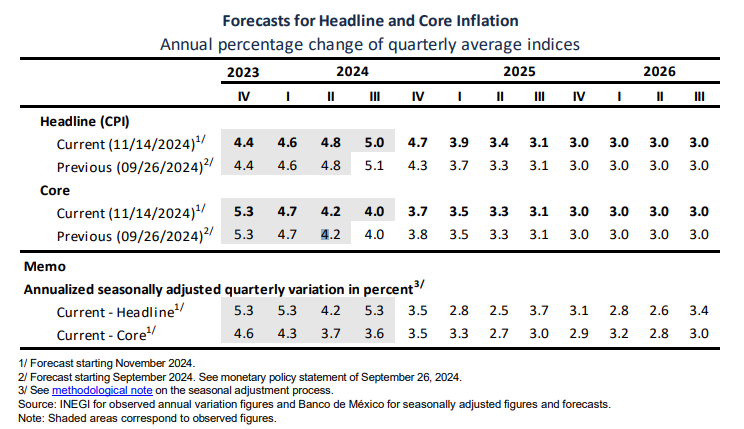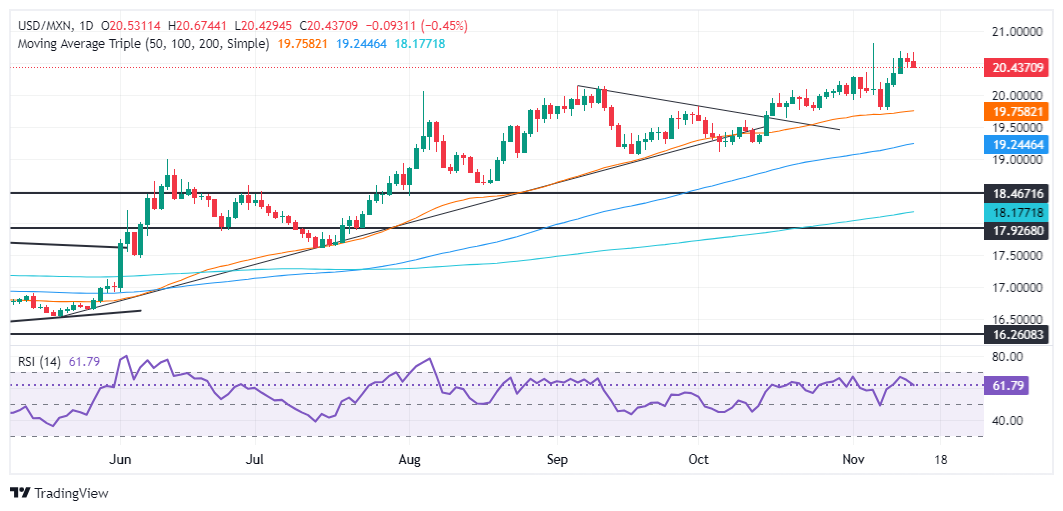- Unanimous decision reflects changed stance since September; further rate cuts may follow as inflation outlook improves.
- Banxico emphasizes continuing economic challenges but sees potential for easing as non-core inflation effects diminish.
- Inflation expected to reach target by Q4 2025, with updated projections suggesting a gradual disinflationary trend.
The Bank of Mexico cut rates by 25 basis points for the fourth time since March 21, diminishing Mexico’s primary reference rate from 10.50% to 10.25%. It’s worth noting that the decision was unanimous after Deputy Governor Jonathan Heath voted to hold rates unchanged at the September meeting.
Bank of Mexico reduces key rate to 10.25%, citing improving inflation outlook and downside economic risks
In its monetary policy statement, Banxico acknowledged that the balance of risks to economic activity growth is skewed to the downside. They added, “the nature of the shocks that have affected the non-core component and the projection that their effects on headline inflation will dissipate over the next quarters.”
The board added the inflationary scenario “will allow further reference rates adjustments,” and although it requires a restrictive monetary policy stance, the evolution of the disinflation process “implies that it's adequate to reduce the level of monetary policy restriction.”
Banxico updated their forecasts for 2024, 2025 and 2025. The board projects that headline inflation will converge to the bank’s 3% target in Q4 2025.
USD/MXN Reaction to Banxico’s decision
The USD/MXN spiked toward 20.55, before printing new daily lows below 20.45. Despite this, the exotic pair bias is tilted to the upside, unless sellers push the exchange rate below 20.00, ahead of testing the 50-day Simple Moving Average (SMA) at 19.74. On the upside, buyers had a clear path to test year-to-date (YTD) highs at 20.80, if they reclaim 20.50.
Banxico FAQs
The Bank of Mexico, also known as Banxico, is the country’s central bank. Its mission is to preserve the value of Mexico’s currency, the Mexican Peso (MXN), and to set the monetary policy. To this end, its main objective is to maintain low and stable inflation within target levels – at or close to its target of 3%, the midpoint in a tolerance band of between 2% and 4%.
The main tool of the Banxico to guide monetary policy is by setting interest rates. When inflation is above target, the bank will attempt to tame it by raising rates, making it more expensive for households and businesses to borrow money and thus cooling the economy. Higher interest rates are generally positive for the Mexican Peso (MXN) as they lead to higher yields, making the country a more attractive place for investors. On the contrary, lower interest rates tend to weaken MXN. The rate differential with the USD, or how the Banxico is expected to set interest rates compared with the US Federal Reserve (Fed), is a key factor.
Banxico meets eight times a year, and its monetary policy is greatly influenced by decisions of the US Federal Reserve (Fed). Therefore, the central bank’s decision-making committee usually gathers a week after the Fed. In doing so, Banxico reacts and sometimes anticipates monetary policy measures set by the Federal Reserve. For example, after the Covid-19 pandemic, before the Fed raised rates, Banxico did it first in an attempt to diminish the chances of a substantial depreciation of the Mexican Peso (MXN) and to prevent capital outflows that could destabilize the country.
Information on these pages contains forward-looking statements that involve risks and uncertainties. Markets and instruments profiled on this page are for informational purposes only and should not in any way come across as a recommendation to buy or sell in these assets. You should do your own thorough research before making any investment decisions. FXStreet does not in any way guarantee that this information is free from mistakes, errors, or material misstatements. It also does not guarantee that this information is of a timely nature. Investing in Open Markets involves a great deal of risk, including the loss of all or a portion of your investment, as well as emotional distress. All risks, losses and costs associated with investing, including total loss of principal, are your responsibility. The views and opinions expressed in this article are those of the authors and do not necessarily reflect the official policy or position of FXStreet nor its advertisers. The author will not be held responsible for information that is found at the end of links posted on this page.
If not otherwise explicitly mentioned in the body of the article, at the time of writing, the author has no position in any stock mentioned in this article and no business relationship with any company mentioned. The author has not received compensation for writing this article, other than from FXStreet.
FXStreet and the author do not provide personalized recommendations. The author makes no representations as to the accuracy, completeness, or suitability of this information. FXStreet and the author will not be liable for any errors, omissions or any losses, injuries or damages arising from this information and its display or use. Errors and omissions excepted.
The author and FXStreet are not registered investment advisors and nothing in this article is intended to be investment advice.
Recommended content
Editors’ Picks

AUD/USD plummets to 0.6250, two-day lows
AUD/USD now retreats from the area of daily highs north of 0.6300 the figure and revisits the mid-0.6200s as investors continue to digest Trump's announcements on "Liberation Day".

EUR/USD loses the grip and retests 1.0800
The US Dollar is now picking up further pace and sends EUR/USD back to the 1.0800 neighbourhood following President Trump's announcements of reciprocal tariffs on Wednesday.

Gold remains well bid near $3,140 post-Trump tariffs
Gold maintains its bullish stance well in place and trade near its record highs in the wake of President Trump's announcement of reciprocal tariffs. In addition, declining US yields also collaborate with the metal's bounce.

Grayscale launches Bitcoin options ETF with a focus on income generation
In a press release on Wednesday, Grayscale announced the launch of Bitcoin options-based ETFs, the Grayscale Bitcoin Covered Call ETF (BTCC) and Grayscale Bitcoin Premium Income ETF (BPI).

Trump’s “Liberation Day” tariffs on the way
United States (US) President Donald Trump’s self-styled “Liberation Day” has finally arrived. After four straight failures to kick off Donald Trump’s “day one” tariffs that were supposed to be implemented when President Trump assumed office 72 days ago, Trump’s team is slated to finally unveil a sweeping, lopsided package of “reciprocal” tariffs.

The Best brokers to trade EUR/USD
SPONSORED Discover the top brokers for trading EUR/USD in 2025. Our list features brokers with competitive spreads, fast execution, and powerful platforms. Whether you're a beginner or an expert, find the right partner to navigate the dynamic Forex market.



